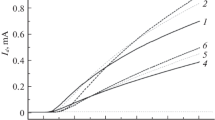Abstract—In the range of transverse magnetic field induction values of 0–4.5 T at temperatures of 100–200 K, the conductivity of the inversion channel of transistor Si-structures is measured after ion polarization and depolarization of samples. It was found that during polarization at a temperature of 420 K under the action of a strong electric field, around 6.5 × 1011 cm–2 ions flowed in the oxide. It was found that, up to the channel opening threshold, conductivity in the source–drain circuit is achieved due to thermal activation of charge carriers to the leakage level in the unordered potential created by the chaotic distribution of ions along the semiconductor surface. It is shown that after opening of the channel (intersection of the Fermi level of holes on the semiconductor surface with the flow level in the chaotic potential), ions appear in the conductivity as additional scattering centers; therefore, in a polarized state, the effective channel mobility is less than in the depolarized one.




Similar content being viewed by others
REFERENCES
E. H. Nicollian and I. R. Brews, MOS (Metal Oxide Semiconductor) Physics and Technology (Willey, Moscow, 1982).
A. Hartstein and A. B. Fowler, Phys. Rev. Lett. 34, 1435 (1975).
T. Ando, A. B. Fowler, and F. Stern, in Electronic Properties of Two-dimensional Systems (Am. Phys. Soc., New York, 1982; Mir, Moscow, 1985), Paragraph 3, Chap. 5.
E. I. Gol’dman and A. G. Zhdan, Tech. Phys, 26, 19 (2000).
E. I. Gol’dman, Yu. V. Gulyaev, A. G. Zhdan, and G. V. Chucheva, Mikroelektronika 30, 364 (2001).
Yu. V. Gulyaev, A. G. Zhdan, and G. V. Chucheva, Semiconductors 41, 357 (2007).
A. G. Zhdan, V. G. Naryshkina, and G. V. Chucheva, Semiconductors 43, 677 (2009).
E. I. Goldman, A. Nabiev, V. G. Naryshkina, and G. V. Chucheva, Semiconductors 53, 85 (2019).
E. I. Gol’dman, A. G. Zhdan, and G. V. Chucheva, Instrum. Exp. Tech. 40, 841 (1997).
Cryomagnetic Not-Liquid System with Induction of 8 Tl (RTI, Tekhnologii, Pribory, Materialy, Moscow, 2012).
T. Hino and K. Yamashita, J. Appl. Phys. 50, 4879 (1979).
D. J. Di Maria, J. Appl. Phys. 52, 7251 (1981).
E. I. Goldman, A. G. Zhdan, and G. V. Chucheva, J. Appl. Phys. 89, 130 (2001).
V. N. Dobrovol’skii and V. G. Litovchenko, Transfer of Electrons and Holes at the Surface of Semiconductors (Naukova Dumka, Kiev, 1985) [in Russian].
A. I. Ansel’m, Introduction to the Theory of Semiconductors (Nauka, Moscow, 1978), p. 513 [in Russian].
V. A. Gergel’ and P. A. Suris, Pis’ma Zh. Eksp. Teor. Fiz. 75, 191 (1978).
Funding
This study was partially supported by the Russian Foundation for Basic Research (project no. 16-07-00666) and the Presidium of the Russian Academy of Sciences (Basic Research Program no. 32 “Nanostructures: Physics, Chemistry, Biology, Fundamentals of Technology”).
Author information
Authors and Affiliations
Corresponding author
Rights and permissions
About this article
Cite this article
Goldman, E.I., Naryshkina, V.G. & Chucheva, G.V. On the Influence of Ionic Polarization of Transistor Si-Structures on the Conductivity of p-Type Channels. J. Commun. Technol. Electron. 64, 1149–1151 (2019). https://doi.org/10.1134/S1064226919100048
Received:
Revised:
Accepted:
Published:
Issue Date:
DOI: https://doi.org/10.1134/S1064226919100048



